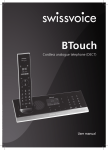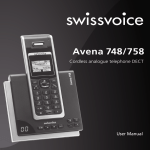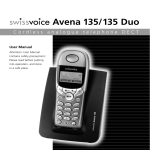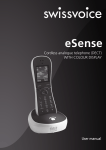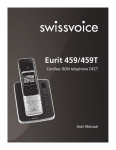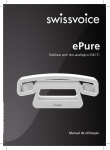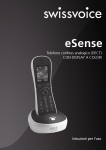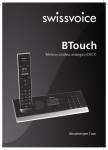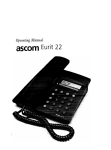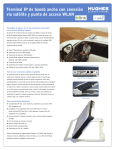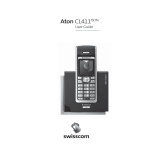Download Eurit 547/557 - Swissvoice.net
Transcript
Eurit 547/557 Cordless ISDN telephone DECT User Manual Important: This user manual contains safety precautions! Please read carefully before putting the telephone into operation, and store in a safe place. Safety precautions This cordless DECT telephone is designed for connection to the public ISDN network. Any other use whatsoever is not permitted and is regarded as in violation of the provisions. The user manual with safety precautions is a part of the product package and must be passed on to the new owner on reselling. Caution! Use only approved rechargeable batteries: Nickel-metal-hydride (Ni-MH AAA 750 mAh). Using other rechargeable batteries or non-rechargeable batteries/primary cells can be dangerous and cause malfunctions in or damage to the telephone. To insert the batteries, please follow the instructions in the chapter entitled “Setting up the handsets”. Please note that the ringer for incoming calls as well as signal tones are emitted on the handset loudspeaker. Do not therefore hold the handset close to your ear while one of these functions is on, otherwise your hearing may be affected. Please note: ➭ Do not immerse batteries in water or throw in the fire. ➭ Rechargeable batteries can become warm while recharging. This is a normal occurrence and is not dangerous. ➭ Do not use any other type of charging unit since this may damage the batteries. ➭ Before using the telephone, wearers of hearing aids should note that radio signals can be picked up by the hearing aid and cause an unpleasant buzzing noise. ➭ Do not use your DECT cordless telephone in environments at risk from explosion (e.g. paintworks, petrol stations etc.) ➭ Do not position the base station or charging station in bathrooms or showers. ➭ The radio signals may influence the working of medical equipment. ➭ In the event of a power cut or if the batteries are discharged, your DECT cordless telephone will not function! ➭ The handset must not be charged up without batteries or the battery cover in place. ➭ Do not touch open contacts! ➭ Use only the mains units supplied for the base station or charging unit. Disposal Please dispose of batteries, base station, handset, charging unit and mains units in an ecological manner. Do not dispose of them in domestic waste. Contents Your Eurit 547 / 557 is designed for connection to the public ISDN network. This telephone is available either with one handset (Eurit 547/557) or as a set with two handsets and a charging bay (Eurit 547/557 Duo). The Eurit 557 offers the additional feature of an integrated digital answer machine. Please read these operating instructions carefully to familiarise yourself with and take full advantage of the benefits of your new Eurit 547 / 557. Keep this user manual in a safe place! Note: These operating instructions describe the full range of functions provided by the Eurit 547 / 557. The functions and instructions described in this user manual may differ or be limited by the characteristics of your network operator or provider. For detailed information on the services available with your ISDN connection, contact your network provider. 20403307en_ba_b0 Safety precautions Setting up the telephone……………………………………………………………………9 Contents of the package ……………………………………………………………………9 Location ………………………………………………………………………………………10 Repeater ………………………………………………………………………………………10 Setting up the base station or charging unit ………………………………………………11 Listening protection …………………………………………………………………………11 Connecting the phone ………………………………………………………………………12 Setting up the handsets ……………………………………………………………………13 Inserting the rechargeable batteries ……………………………………………………13 Charging the batteries …………………………………………………………………14 Installation assistant …………………………………………………………………………15 Multiple Subscriber Numbers (MSN) ………………………………………………………16 Changing users …………………………………………………………………………16 1 Contents Getting to know your telephone ………………………………………………………17 Handset keys …………………………………………………………………………………17 Handset display symbols ……………………………………………………………………19 About the menus ……………………………………………………………………………20 Menu navigation …………………………………………………………………………20 Back to previous menu …………………………………………………………………20 End menu …………………………………………………………………………………20 Eurit 557 base station with answer machine ………………………………………………21 Eurit 547 base station ………………………………………………………………………22 20403307en_ba_b0 Telephoning …………………………………………………………………………………23 Making an external call ………………………………………………………………………23 Call preparation …………………………………………………………………………23 Ending a call ……………………………………………………………………………23 Accepting a call ………………………………………………………………………………23 Reject call ……………………………………………………………………………………23 Send DTMF/keypad information ……………………………………………………………23 Handsfree operation …………………………………………………………………………24 Handset / handsfree volume …………………………………………………………………24 Handset secrecy ………………………………………………………………………………24 Redial …………………………………………………………………………………………25 Redialling a number from the list ………………………………………………………25 Copying numbers from the redial list …………………………………………………25 Deleting individual entries/entire redial list ……………………………………………25 Sending SMS messages from the redial list* …………………………………………26 Group call (paging) …………………………………………………………………………26 Keypad lock …………………………………………………………………………………26 Internal calls …………………………………………………………………………………27 * Function dependent on network operator. Contact your network operator to find out whether this service is supported. 2 Contents Enquiries ………………………………………………………………………………………28 Internal enquiry call ……………………………………………………………………28 External enquiry call ……………………………………………………………………28 Brokering (switching between two calls) …………………………………………………28 Call transfer …………………………………………………………………………………29 Internal call transfer ……………………………………………………………………29 External call transfer ……………………………………………………………………29 Three-way conference ………………………………………………………………………30 Phonebook……………………………………………………………………………………31 Directory entries ………………………………………………………………………………31 Adding a new entry ……………………………………………………………………31 Tips for entering names/numbers ………………………………………………………31 Editing entries ……………………………………………………………………………32 Deleting directory entries/entire directory ……………………………………………32 Dialling numbers from the directory ………………………………………………………32 Sending SMS messages from the directory* ………………………………………………32 Copying directory entries ……………………………………………………………………33 Copying entries/entire directory to another handset …………………………………33 20403307en_ba_b0 Calls list* ……………………………………………………………………………………34 Viewing/dialling a number from the calls list ………………………………………………34 Sending SMS messages from the calls list* ………………………………………………34 Saving numbers from the calls list to the directory ………………………………………34 Deleting individual entries …………………………………………………………………35 Deleting the entire calls list …………………………………………………………………35 * Function dependent on network operator. Contact your network operator to find out whether this service is supported. 3 Contents Audio …………………………………………………………………………………………36 Handset/base station ringer …………………………………………………………………36 Tones …………………………………………………………………………………………36 Key beeps …………………………………………………………………………………36 Range beeps ……………………………………………………………………………36 Charging beep ……………………………………………………………………………36 Accu beep ………………………………………………………………………………36 Confirmation beep ………………………………………………………………………36 Family …………………………………………………………………………………………37 Direct call (baby call) …………………………………………………………………………37 Room monitoring (baby surveillance) ………………………………………………………38 Call costs ……………………………………………………………………………………39 Cost of last call ………………………………………………………………………………39 Summary ………………………………………………………………………………………39 Settings ………………………………………………………………………………………39 Type of display ……………………………………………………………………………39 Charge factor ……………………………………………………………………………39 Currency …………………………………………………………………………………39 20403307en_ba_b0 Calendar/clock ………………………………………………………………………………40 Appointments ………………………………………………………………………………40 Alarm …………………………………………………………………………………………40 Time/date ……………………………………………………………………………………40 Network functions (supplementary services) …………………………………………41 Call forwarding ………………………………………………………………………………41 Unconditional ……………………………………………………………………………41 No reply …………………………………………………………………………………41 Busy ………………………………………………………………………………………41 Anonymous call (Identification restriction) …………………………………………………42 Conference assistant …………………………………………………………………………42 4 Contents Parking ………………………………………………………………………………………42 Park/unpark ………………………………………………………………………………42 Park ID ……………………………………………………………………………………42 Recall …………………………………………………………………………………………43 Call back on busy (Completion of Calls to Busy Subscriber/CCBS) …………………43 Auto Redial ………………………………………………………………………………43 Malicious Call Identification (MCID) ………………………………………………………43 Network answer machine (voicebox) ………………………………………………………44 Provider ………………………………………………………………………………………44 20403307en_ba_b0 SMS ……………………………………………………………………………………………45 SMS – Short Messaging Service ……………………………………………………………45 Writing SMS messages ………………………………………………………………………45 Inbox …………………………………………………………………………………………46 Drafts …………………………………………………………………………………………46 Outbox ………………………………………………………………………………………46 Templates ……………………………………………………………………………………47 Settings ………………………………………………………………………………………47 SMS service centre ………………………………………………………………………47 Send service ………………………………………………………………………………47 New SMS alert ……………………………………………………………………………47 Answer machine (Eurit 557 only) ………………………………………………………48 Select MSN (answer machine is in standby): …………………………………………48 The following settings can be defined per MSN ………………………………………48 Operating the answer machine from the handset …………………………………………49 On/off ……………………………………………………………………………………49 Outgoing messages ……………………………………………………………………49 Recording/playing back an outgoing message ………………………………………49 Deleting an outgoing message …………………………………………………………50 Selecting an outgoing message …………………………………………………………50 Memo ……………………………………………………………………………………50 5 Contents Message playback ………………………………………………………………………50 Delete messages …………………………………………………………………………51 Listening over the handset ………………………………………………………………51 Recording a call …………………………………………………………………………51 Remaining time …………………………………………………………………………51 VIP number* ……………………………………………………………………………51 SMS notification* ………………………………………………………………………52 Operating the answer machine on the base station ………………………………………52 On/off ……………………………………………………………………………………52 Playing, repeating, deleting and skipping messages …………………………………52 Delete all listened messages ……………………………………………………………52 Listening over the base station …………………………………………………………52 Answer machine settings ……………………………………………………………………53 Answer delay and time saver mode ……………………………………………………53 Time limit …………………………………………………………………………………53 Language …………………………………………………………………………………53 Remote access ………………………………………………………………………………53 Remote access PIN ………………………………………………………………………53 Remote activation of answer machine ………………………………………………54 PIN alarm …………………………………………………………………………………54 Operating the answer machine from an external telephone …………………………54 20403307en_ba_b0 Settings ………………………………………………………………………………………55 Language ……………………………………………………………………………………55 Display …………………………………………………………………………………………55 Font ………………………………………………………………………………………55 Contrast …………………………………………………………………………………55 Backlight …………………………………………………………………………………55 * Function dependent on network operator. Contact your network operator to find out whether this service is supported. 6 Contents Telephony ……………………………………………………………………………………56 Automatic DTMF …………………………………………………………………………56 Auto Talk …………………………………………………………………………………56 System PIN ……………………………………………………………………………………56 PBX ……………………………………………………………………………………………57 Coverage ……………………………………………………………………………………57 Repeater Mode …………………………………………………………………………57 Eco Mode (antenna off) …………………………………………………………………58 MSN settings …………………………………………………………………………………58 Assigning an MSN ………………………………………………………………………58 Allocating an MSN ………………………………………………………………………58 Additional handsets/base stations ………………………………………………………59 Registering additional handsets ……………………………………………………………59 Deregistering a handset ……………………………………………………………………59 Selecting the base station ……………………………………………………………………59 PBX access ……………………………………………………………………………………60 Compatibility …………………………………………………………………………………60 Exchange Access Code EAC …………………………………………………………………60 Entering the EAC ………………………………………………………………………60 Incoming EAC on/off ……………………………………………………………………60 Maintenance …………………………………………………………………………………61 Reset …………………………………………………………………………………………61 20403307en_ba_b0 General information ………………………………………………………………………62 Approval and conformity ……………………………………………………………………62 Warranty conditions …………………………………………………………………………62 Warranty Certificate ………………………………………………………………………63 7 8 20403307en_ba_b0 Setting up the telephone Contents of the package Eurit 547 / 557 ➭ ➭ ➭ ➭ ➭ ➭ ➭ 1 1 1 1 2 1 1 base station connector cable mains unit handset rechargeable batteries user manual belt clip (mounted) Additional items for Eurit 547/557 Duo ➭ Second handset ➭ 2 additional rechargeable batteries ➭ Charging bay (for the second handset) with power supply The following optional accessories is available: 20403307en_ba_b0 ➭ headset 9 Setting up the telephone Location To obtain the best possible range, we recommend positioning the telephone in a location central to your sphere of activity. Avoid positioning the telephone in niches, recesses and behind steel doors. The maximum range between the base station and handset is approximately 40 meters indoors and 250 meters outdoors. Depending on the surrounding conditions as well as spatial and structural factors, the range may be smaller. Silent zones can occur due to the digital transmission in the frequency range used – even within the range, depending on the structural environment. In this case the transmission quality may be reduced through the increased incidence of short breaks in transmission. Normal call quality can be restored if you move slightly out of the silent zone. If the range is exceeded, the call will be disconnected unless you move back into range within five seconds. To avoid radio signal interference from other electronic equipment, we recommend that the base station and handset are situated at the greatest possible distance (min. 1 meter) from other equipment. Repeater 20403307en_ba_b0 You can use a repeater to extend the range and receiving power of your base station. The repeater must first be registered and activated on the base station. (Your telephone is delivered with the default setting “off”). 10 Setting up the telephone Setting up the base station or charging unit ➭ Do not expose the base station or charging unit to direct sunlight. ➭ Protect the base station or charging unit against moisture. Do not position the base station or charging unit in rooms exposed to condensation, corrosive steam or excessive dust. Condensation can be present in basements, garages, conservatories or sheds. ➭ The ambient temperature must be between 5 °C and 40 °C. Position the base station and charging unit in a clean, dry and well-aired location. Choose a place which is stable, level, and not subject to vibrations. To avoid mutual interference, do not position the base station or charging unit in the immediate vicinity of electronic equipment such as hi-fi systems, office equipment or microwave ovens. Avoid positioning the telephone near heat sources such as heating elements or near obstacles such as metal doors, thick walls, niches and cupboards. There is no mains switch on the base station or charging unit. For this reason the socket to which it is connected must be easy to access. Listening protection 20403307en_ba_b0 When you are on the telephone, the base station and handset are connected to each other over a radio link. The base station handles switching between the telephone network and the handset. To ensure that no-one can eavesdrop or telephone at your cost, the base station and handset exchange codes. If the codes do not match, the connection with third-party handsets cannot be set up. 11 Setting up the telephone Connecting the phone Before you can start using your telephone you must plug in the telephone connector cable and the mains cable. ➁ Socket for mains cable ➀ Socket for telephone connector cable Safety note Use only the mains units supplied for the base station or charging unit. ➀ Telephone connector cable The telephone connector cable has two different plugs. Insert the smaller plug in the socket marked with the telephone symbol on the base station, and fit the cable into the corresponding cable duct. Insert the larger plug in your telephone connection socket. ➁ Mains cable First, insert the mains cable in the socket marked with the mains connector symbol on the base of the base station or charging unit, and fit the cable in the moulded cable duct. Then insert the mains plug in the 230 V socket. Your telephone will not function if the mains connector is not plugged in or during a power failure. 20403307en_ba_b0 Note 12 Setting up the telephone Setting up the handsets Your handsets will be ready for operation (for making or accepting calls) only once the batteries have been fully charged for the first time. Inserting the rechargeable batteries The bottom part of the handset contains a battery compartment for housing two type AAA batteries (microcells). Removing the battery compartment cover: Slide the battery compartment cover downwards (approx.3 mm) and lift. 20403307en_ba_b0 Inserting the two rechargeable batteries (note the polarity!): Insert the batteries in the battery compartment. Make sure the polarity is correct. Insert the batteries so that the flat end (negative polarity) of the battery is pressing against the spring. The handset will not function if the batteries are incorrectly inserted. This may result in damage. Replace the compartment cover by placing it approximately 3 mm offset and slide it upwards until it clicks into place. 13 Setting up the telephone Charging the batteries The batteries are not yet charged when you first unpack the telephone. Insert the handset in the base station or charging unit for charging. The flashing battery symbol on the handset shows the charging status. The batteries will take around 13 hours to fully charge. Note • Do not insert the handset in the base station or charging unit without batteries. • Do not use any other type of charging unit since this may damage the batteries. The following symbols indicate the charging status on the handset display: Charging status “empty” Charging status “1/2” Charging status “full” Once the new batteries have been inserted, the display on the handset indicates the actual charging status only after a complete charging cycle. 20403307en_ba_b0 Your telephone is now ready to use. Important! Please note: after you have inserted the batteries for the first time, the battery display will indicate the correct information on the charging status only after a complete charging cycle. Use only NiMH rechargeable batteries. Never use disposable batteries/primary cells. ! 14 Setting up the telephone Note You can replace the handset in the charging/base station after every call. Charging is electronically controlled to ensure optimal charging of batteries in different charge states. Avoid removing the batteries from the handset for no good reason, since this affects the optimum charging cycle. Because your telephone is fitted with a low-radiation mechanism, the antenna automatically switches off in standby mode and cannot therefore emit any radiation. Your telephone is delivered with this function switched off. You can telephone for up to 17 hours with fully charged batteries. The handset has a standby time of up to 170 hours. If the battery charge status has reached its lower limit, the battery symbol ( ) flashes in the display and a warning signal is heard. You have 10 minutes of talk time left. Installation assistant An installation assistant simplifies things for you by guiding you step by step through the setup procedure for your telephone. Follow the displayed instructions and enter the preferred language, all MSN numbers along with user name, as well as time and date. Note • The installation assistant will re-appear following a reset of the telephone (reset to default settings). 20403307en_ba_b0 • You can also enter the preferred language, MSNs, time and date in the corresponding menus. 15 Setting up the telephone Multiple Subscriber Numbers (MSN) When you ordered your ISDN connection, your network operator will have assigned you several Multiple Subscriber Numbers (MSN). You can assign these numbers to different devices or assign individual numbers to different users. Every MSN (user) can then define individual settings for the number assigned to him or her. Your telephone can manage up to 5 MSNs. To use all the functions, you must set up at least one MSN with user name (see section on “Assigning an MSN”). Changing users To change users, press the softkey under MENU. Use to scroll to CHANGE USER and select the relevant user. The current user is displayed. You can now access the activated user’s calls lists, charge displays and individual settings. To find out how to set preferences for individual MSNs, refer to the section on “MSN settings”. The CHANGE USER menu can only be accessed if more than one MSN has been programmed. 20403307en_ba_b0 Note 16 Getting to know your telephone Handset keys Earpiece Backlit display Navigation key Softkey (multifunctional key) Softkey (multifunctional key) Redial Message key Internal call key Call list Talk key «End call» key Headset connectivity Alphanumerical keypad 20403307en_ba_b0 Hash key Enquiry key with flash function ! Activating the key lock Key «Write SMS Message» Microphone 17 Getting to know your telephone Softkeys (multifunctional keys) Right softkey: Choose menu options, confirms entries/settings. Left softkey: returns to previous menu step. Navigation key For scrolling up/down or right/left. In answer machine mode, message playback: right = skip forward, left = replay message; double click = skip back. Redial Open redial list. Message key messages. Access to new missed calls, SMS* or answer machine Opens calls list*. INT Internal call key For conducting handset-to-handset calls. Call key For conducting and accepting calls and switching to handsfree. “End call” key Press briefly to end a call or return to standby mode. Press and hold down to switch the handset on/off. … Alphanumerical keypad For dialling telephone numbers. Letters printed on housing. Press and hold down “0” when entering a telephone number to insert a dialling pause between two digits. Voicebox Press and hold down for direct access to network answer machine messages. Call back on busy back on busy. Press and hold if called party is busy: Activate call Call anonymously Press and hold down to suppress caller ID for next call. Park / unpark Press and hold during call: Park. Press and hold in standby mode: Unpark. 20403307en_ba_b0 Asterisk key For entering asterisks. Press and hold down to switch handset ringer on/off. Hash key For entering the hash symbol. Press and hold down to switch keylock on. * Function dependent on network operator. Contact your network operator to find out whether this service is supported. 18 Getting to know your telephone Keypad locked inadvertently. Enquiry key ! A locked keypad prevents numbers being dialled with flash function. Key “Write SMS Message” Write SMS message. Handset display symbols The following symbols are displayed on your handset. Coverage symbol Reception displayed when the handset is within range of the base station. Flashes when out of range of the base station or not registered with the base station. Battery full Indicates that the batteries are fully charged. Alarm set Indicates that the alarm is set. Missed calls* Displayed if you have missed calls in the calls list. Handsfree on Indicates that handsfree speaking is activated. Active call Indicates that a call is in progress. You have new SMS messages* Indicates that you have new SMS messages. Answer machine Indicates that the answer machine is set and that you have new messages on your answer machine. Ringer off Indicates that the ringer is switched off. You have messages on your voicebox* Displayed if you have new messages on your voicebox. Keypad lock Indicates that the keypad is locked. Call forwarding activated Indicates that call forwarding is activated. 20403307en_ba_b0 Battery empty Indicates that the batteries are almost discharged. Recall Indicates that “call back on busy” is activated. ) Auto Redial Indicates that Auto Redial is activated. * Function dependent on network operator. Contact your network operator to find out whether this service is supported. 19 Getting to know your telephone About the menus Menu navigation Your handset provides you with an easy-to-follow menu. As a rule, every menu offers a list of options. To select main menu, sub-menu and options, press the softkey below the corresponding display text. With the handset switched on and ready for use, press the softkey under MENU to open the main menu and use the navigation key to scroll to the option you are seeking. Press OK to open the options list, use the navigation key to scroll down the list to the preferred option, and confirm the option by pressing OK. Back to previous menu Press BACK to return to the previous menu. End menu 20403307en_ba_b0 To exit a menu, press the softkey under BACK. If you want to return to standby mode, confirm by pressing . 20 Getting to know your telephone Eurit 557 base station with answer machine Eurit 557 Previous Stop Next Adjust loudspeaker “In volume operation” display Playback/ replay 20403307en_ba_b0 Delete Switches the answer machine on or off Message counter/ status indicator 21 Group call on handsets (paging) Getting to know your telephone Eurit 547 base station Eurit 547 Group call on handsets (paging) 20403307en_ba_b0 “In operation” display 22 Telephoning Making an external call Press , wait for the dialling tone and dial the number. Call preparation First, enter the number. If you enter an incorrect number, you can delete the entry. Press to dial the number. Ending a call Press or replace the handset in the charging unit/base station. Accepting a call The caller’s number or name (if stored in the directory) are displayed only if your network operator supports caller line ID (Caller Line ID Presentation/CLIP*). Press to accept the call. Reject call You can reject an incoming call. Press to reject the call. Send DTMF / keypad information By switching to temporary DTMF you can press the softkey under OPTION, DTMF to send control signals, e. g. for the network answer machine, during a call. 20403307en_ba_b0 Note If you have activated “Autom. DTMF” in the SETTINGS, TELEPHONY menu, there is no need to switch to temporary DTMF. Temporary DTMF is automatically deactivated when you end the call. * Function dependent on network operator. Contact your network operator to find out whether this service is supported. 23 Telephoning Handsfree operation You can use the handsfree function to conduct calls without holding the handset in your hand and allow others present in the room to take part in the call. Activating handsfree before a call: 1. Press . The display shows . Press again. The display shows can hear the ringing signal over the handset loudspeaker. 2. Press and you to deactivate handsfree speaking. Switching to handsfree speaking during a call: Press . To deactivate handsfree speaking, press again. Handset / handsfree volume You can adjust the handset and handsfree loudspeaker volume in 5 steps. Press during a call to adjust the volume. The selected setting is saved after the end of the call. Note The handset and handsfree loudspeaker volumes are independent but the setting procedure is identical. Handset secrecy During a call you can talk to someone else in the room without the caller hearing. 20403307en_ba_b0 1. Press the softkey under SECRECY during a call. This switches handset secrecy on and your caller cannot hear you. 2. Press the softkey under OFF to return to the call. 24 Telephoning Redial The 15 last-dialled numbers are saved in a redial list. If a name and number are already stored in the directory, the name is shown instead of the number. Redialling a number from the list Press to open the redial list and press to scroll through the list. Press as you have reached the number you are seeking. Note as soon If the redial list is empty, a message to this effect appears. Copying numbers from the redial list You can copy a number from the redial list to the directory. Press to open the redial list. Use to scroll through the list to find the number you are seeking, and press the softkey under OPTION. Enter the name and number and define your individual settings. Assign the entry to the relevant user and save. Note If the number is already in the directory, the Save function is not displayed. Deleting individual entries/entire redial list 20403307en_ba_b0 Press to open the redial list. Scroll through until you reach the entry you are seeking. Press the softkey under OPTION and delete the entry or the entire list. 25 Telephoning Sending SMS messages from the redial list* 1. Press the softkey under . Use to scroll through the list to find the entry you are seeking, and press the softkey under OPTION. 2. Write and send your SMS message. Group call (paging) You can activate a group call to locate a mislaid handset. 1. Press on the base station. The mislaid handset rings. 2. Press again to end the ringing signal or press on the handset. Keypad lock If you want to carry the handset around in your pocket, you can activate the key lock. This prevents you inadvertently dialling a number. 1. Press and hold down . The display shows KEYPAD LOCKED. 2. To unlock the keypad, press the softkey under UNLOCK, then press Note . If the keypad is locked, • you can dial the emergency numbers 110, 112, 117, 144 (in call preparation only) and incoming calls can still be accepted. 20403307en_ba_b0 • you cannot dial a number or access menus. * Function dependent on network operator. Contact your network operator to find out whether this service is supported. 26 Telephoning Internal calls You can call other handsets which are registered with your base station. This allows you to make internal calls free of charge. 1. Press INT, dial the relevant handset number and press OK to confirm. Pressing INT automatically dials the second handset if only two handsets are registered with the base station. 2. Press Note to end the call. • If you receive an external call while conducting an internal call, every handset which is not in use will ring. 20403307en_ba_b0 • If a handset is in use, you will hear a signal alerting you to the incoming external call. Press the softkey under OPTION, ACCEPT/END to end the internal call and accept the external call. Or press the softkey under OPTION, ACCEPT/HOLD to put the internal call on hold or under OPTION, REJECT to reject the external call. 27 Telephoning Enquiries Internal enquiry call You are conducting a call and want to call an internal party without ending the external call. Internal enquiries are managed by the base station and are not dependent on your network operator’s available services. External enquiry call Procedure: 1. You are conducting a call and want to call another external party without ending the active external call. 2. Press the enquiry key to start the external enquiry. Brokering (switching between two calls) You have two active calls (1 internal and 1 external), one of which is on hold. You can switch between the two by brokering. 1. You are conducting two calls, one of which is on hold. 2. Press the softkey under OPTION, BROKERING to switch between the call partners. 3. Press to end one of the calls. The remaining call partners are automatically connected with each other. You can connect all call partners together by pressing the softkey under OPTION, JOIN. 20403307en_ba_b0 Note 28 Telephoning Call transfer Internal call transfer You can transfer the call you are conducting to another handset (= switching). 1. Press INT and dial the handset to which you wish to transfer the call. The external caller is put on hold. 2. If the second handset answers, you can talk to the internal call partner without the external caller hearing you. Press to transfer the call. Note • You cannot use the INT key if the call duration is not displayed. • If the second handset does not answer, you can end the ringing signal and return to the original call by pressing the softkey under END. External call transfer 20403307en_ba_b0 You can transfer an incoming call to another telephone directly by pressing the softkey under OPTION, CD. You can enter the number you normally transfer your calls to in the menu FUNCTIONS, CALL DEFLECTION (CD). 29 Telephoning Three-way conference You can use the conference assistant to set up a three-way conference with 2 external call parties. 1. Scroll to FUNCTIONS, CONFERENCE ASSISTANT and press OK to confirm. 2. Dial the number of the call partner or search for it in the directory. Once the connection is set up, tell the call partner that you are setting up a three-way conference call. The call partner is put on hold. 3. Dial the number of the second call partner or search for it in the directory. The three-way conference call is activated as soon as the second call partner accepts the call. If the second call partner does not answer, you can return to the first call partner by pressing the softkey under END. 20403307en_ba_b0 Note 30 Phonebook You can store up to 100 names and numbers in the directory on each handset. Every entry contains a name and telephone number. Names can be up to 16 letters long and numbers up to 24 digits long. Directory entries Adding a new entry If the telephone is in standby mode: 1. Press the softkey under NAMES. All entries are displayed in alphabetical order. 2. Press the softkey under OPTION. Enter the new name and number and define your individual settings. Assign the entry to the relevant user and save. Note If the directory is empty, a message to this effect is displayed. Tips for entering names/numbers • Press to insert a space, or to enter a symbol. • The available special characters appear in the lower display line. Press the relevant key to scroll through the characters. to switch between upper and lower case 20403307en_ba_b0 • When entering names, you can press lettering. 31 Phonebook Editing entries 1. Press the softkey under NAMES. Use to scroll through the list to find the entry you are seeking, and press the softkey under OPTION. 2. Edit the name and/or number and save the entry. Deleting directory entries/entire directory You can delete individual entries or the entire directory. 1. Press the softkey under NAMES. Use to scroll through the list to find the entry you are seeking, and press the softkey under OPTION. 2. Delete the entry or the entire list. Dialling numbers from the directory 1. Press the softkey under NAMES. All entries are displayed in alphabetical order. 2. Use to scroll through the directory, select the entry you are seeking and press The number is displayed and dialled. You can also search by name: press the first letters of the name and press firm. . to con- Sending SMS messages from the directory* 1. Press the softkey under NAMES. Use to scroll through the list to find the entry you are seeking, and press the softkey under OPTION. 20403307en_ba_b0 2. Write and send your SMS message. * Function dependent on network operator. Contact your network operator to find out whether this service is supported. 32 Phonebook Copying directory entries If you operate several handsets, you can copy entries from one handset to another. This way, you only have to enter names and numbers once. While you are copying entries from one handset to another, you can make external calls on another handset registered with the base station. If the entire directory is copied, it overwrites all entries on the other handset. If the directory on the handset to which you are copying is full, a message to this effect is displayed. Copying entries/entire directory to another handset You can copy individual entries or the entire directory from one handset to another provided both handsets are registered with the base station. 1. Press the softkey under NAMES and to select the entry you wish to copy. Press the softkey under OPTION. Select the submenu you are seeking and press OK to confirm. 2. Select the number of the destination handset and press OK to confirm. Note • The copy procedure is aborted if an incoming call is received. • If you are copying an entire directory, all entries transferred before the call are saved. 20403307en_ba_b0 • You cannot perform the copy procedure if the handset to which you wish to copy is conducting a call. 33 Calls list* If your network operator supports caller line ID* (CLIP), the caller’s number (unless withheld) is displayed before you accept the call. If you have received new calls, a message to this effect appears in the display. A list is kept of answered and missed calls. The calls list can hold up to 30 entries. If the list is full, the oldest entry is overwritten by the most recent entry. Note If the calls list is empty, a message to this effect is displayed. Viewing/dialling a number from the calls list Press to open the calls list. Press to dial the number. to scroll through the relevant calls list. Press Sending SMS messages from the calls list* 1. Press to open the calls list. Use to scroll through the relevant calls list to find the entry you are seeking, and press the softkey under OPTION. 20403307en_ba_b0 2. Write and send your SMS message. * Function dependent on network operator. Contact your network operator to find out whether this service is supported. 34 Calls list* Saving numbers from the calls list to the directory 1. Press . Scroll through the relevant calls list until you reach the entry you are seeking. 2. Press the softkey under OPTION, SAVE NUMBER. Enter the name for the associated number and define your individual settings. Assign the entry to the relevant user and save. Deleting individual entries 1. Press . Scroll through the relevant calls list until you reach the entry you are seeking. 2. Press the softkey under OPTION, DELETE CALL and delete the entry. Deleting the entire calls list 20403307en_ba_b0 Press and DELETE ALL CALLS to delete the entire list. * Function dependent on network operator. Contact your network operator to find out whether this service is supported. 35 Audio Procedure: 1. Press the softkey under MENU. Press to scroll to AUDIO ad press OK to confirm. 2. Scroll to the relevant submenu and make the relevant settings: Handset/base station ringer You can programme different ringer melodies for each MSN on the handset and base station, to signal external and internal calls. Choose from the 5 standard and 10 polyphonic ringer melodies in the handset and 10 standard ringer melodies in the base station. Set the preferred ringer melodies and associated volume for external/internal calls. You can also set an increasing volume. Tones Your telephone supports various tones which you can activate or deactivate: Key beeps Every time a key is pressed, a brief beep is heard. Range beeps A warning beep is sounded if you exceed the maximum range. Move closer to the base station. Charging beep When you insert your handset in the charging unit/base station, the batteries are automatically charged up. A short beep is heard. 20403307en_ba_b0 Accu beep Sounds when the batteries are running low. Confirmation beep Settings and entries are confirmed by a short beep. 36 Family Procedure: 1. Press the softkey under MENU. Press to scroll to FAMILY and press OK to confirm. 2. Scroll to the relevant submenu and make the relevant settings: Direct call (baby call) If you activate direct call on your telephone, the handset dials a preprogrammed number when any handset key is pressed. “Direct call” can be very useful, especially for parents with young children. If the parents are not at home, the children can reach their parents (or neighbours) simply by pressing any key on the handset. The direct call number must be preprogrammed by the parents beforehand. Note • You must deactivate the direct call function to restore your telephone’s normal functions. 20403307en_ba_b0 • Please note that direct call may not function in exceptional cases, e.g. if the preprogrammed number is busy, if the preprogrammed mobile phone number has no reception, in case of a power outage or when the recheargable batteries are empty. 37 Family Room monitoring (baby surveillance) You can set a baby call/noise alarm. Once this function is set, your phone monitors noises in its immediate vicinity and triggers a call to the programmed number if the noise exceeds a set level (defined by the user). The person called hears the noises and is alerted to the fact that, for instance, a child is crying in the room. Note • If room monitoring is active, incoming calls are not signalled. • If the answer machine is activated, an incoming call is forwarded to it. • You must deactivate the room monitoring function to restore your telephone’s normal functions. 20403307en_ba_b0 • Please note that room monitoring may not function in exceptional cases, e.g. if the preprogrammed number is busy, if the preprogrammed mobile phone number has no reception, in case of a power outage or when the recheargable batteries are empty. 38 Call costs Procedure: 1. Press the softkey under MENU. Press to scroll to CHARGES and press OK to confirm. 2. Scroll to the relevant submenu and make the relevant settings: Cost of last call You can display the cost of the last call as well as call charges per MSN or handset. Summary You can display the total per handset and the total for all MSNs. Settings Type of display You can display the cost or duration of a call. The following settings must be made before you can display costs: Charge factor To display costs accurately, you must set the charge per unit (factor). This factor is automatically transmitted for every outgoing call in the ISDN network. Currency To display costs accurately, you may need to set the currency. 20403307en_ba_b0 Note • Note that for technical reasons the displayed charges may differ from the amount billed. The amount indicated on your phone bill is binding. • If you are using a provider, charge information may not be available. 39 Calendar/clock Procedure: 1. Press the softkey under MENU. Press to confirm. to scroll to CALENDAR/CLOCK and press OK 2. Scroll to the relevant submenu and make the relevant settings: Appointments Your telephone also acts as an appointments reminder: You can set 5 different appointment reminders. The relevant melody is played on the handset at the defined time. You can choose from 5 standard and 10 polyphonic melodies. Note As soon as the time of the appointment arrives, it is displayed and the phone rings during a certain time. By pressing the softkey under SILENCE (or after the ringing), the appointment will further be displayed. If you do not need the reminder in the display any longer, press CLEAR. Alarm To set the alarm, you need to activate the alarm function and enter the time and preferred alarm melody. You can choose from 5 standard and 10 polyphonic alarm melodies. Note The alarm only sounds on the handset on which it has been set. Time/date 20403307en_ba_b0 The time and date are automatically set when an outgoing call is made. Note • If the power supply is cut, the settings are lost and must be preprogrammed. • You can also set the time format (12/24 hours). 40 Network functions (supplementary services) Network functions are dependent on your network operator. Find out about availability and charges, if applicable. Procedure: 1. Press the softkey under MENU. Press to scroll to FUNCTIONS and press OK to confirm. 2. Scroll to the relevant submenu and make the relevant settings: Call forwarding Call forwarding allows callers to reach you even if you are not near your own telephone. Choose the relevant type of call forwarding (unconditional, no reply, busy) in the submenu TURN ON or TURN OFF and enter the forwarding number (i.e. the number to which calls are to be forwarded). Unconditional Incoming calls are forwarded immediately. No reply Incoming calls are forwarded after a delay (fixed time or number of rings). Busy Calls are forwarded if the line is busy. Once you have defined the call forwarding option, enter the forwarding number (i.e. the number to which calls are to be forwarded). 20403307en_ba_b0 At any time you can: • check the call forwarding status • edit or delete the forwarding number • deactivate call forwarding. 41 Network functions (supplementary services) Anonymous call (Identification restriction) When you call someone, your number is shown on the other person’s phone if it supports this function. You can program your MSN so that your calling line ID is suppressed (see section on “MSN settings”). “Anonymous call” for the next call only can also be activated in the relevant menu or by pressing and holding down the key . “Anonymous call” can also be assigned to a directory entry. Conference assistant See section on “Three-way conference”. Parking Park/unpark You can park an external call for 3 minutes and retrieve it on another telephone with the same connection. Press and hold during the call: Park. Press and hold in standby mode: Unpark. Park ID 20403307en_ba_b0 Your telephone is delivered with the park code preset to 1. You can change the park code in the relevant menu. Press SAVE to confirm. The park code is used to clearly identify the parked connection, and must be entered when unparking. 42 Network functions (supplementary services) Recall This service is dependent on your network operator. Call back on busy (Completion of Calls to Busy Subscriber / CCBS) If a number you have dialled is busy, you can activate call back by pressing the softkey under CCBS or by pressing and holding down (the acitvated call back is signalled in the display with ). If call back on busy is activated, the ringer is played as soon as the called party has replaced the receiver i.e. as soon as his or her line becomes free. Note An activated call back can be deactivated in the menu FUNCTIONS, DEACT. CALLBACK. Auto Redial The automatic redial calls for you an occupied number in regular intervals. Note An activated auto redial can be deactivated in the menu NETWORK FUNCTIONS, DEACTIVATE AUTO REDIAL. Malicious Call Identification (MCID) 20403307en_ba_b0 This service is available from your network operator on request. Once your network operator has activated the service, malicious calls are registered during the call and up to 20 seconds after the receiver is replaced. The exchange registers the calling number, date and time, even if the caller has withheld his or her number. 43 Network functions (supplementary services) Network answer machine (voicebox) Many network operators offer the option of setting up a network answer machine (Voicebox). Check whether this network function is available, the associated charges (if applicable) and the functions provided by this service. is displayed to alert you to new messages (if provided by network operator). To access new messages quickly and simply, press and hold down for around 2 seconds to automatically dial the access number of your network answer machine. Note • You can edit the network answer machine access number (Voicebox) in the submenu VOICEBOX, SETTINGS. • To use the network answer machine, you need to send certain codes to the network. Ask your network operator for details. Provider You can also make calls over another provider. Under PROVIDER LIST, enter the names and prefixes of the providers (max. 5) to whose service you have subscribed. You can link every directory entry to one of the providers in this list. 20403307en_ba_b0 If you want to make all calls over a single provider, scroll to DEFAULT PROVIDER in the submenu SETTINGS and enter the relevant provider’s prefix. The default provider prefix is then automatically inserted before every number you call from lists (even if you have not saved a provider prefix in the directory entries). Note The default provider prefix is only inserted automatically if you dial from a list (directory, calls list, redial). 44 SMS SMS – Short Messaging Service Sending and receiving SMS messages is a network function. To send and receive SMS messages, your telephone line must have active Caller Identification Presentation (CLIP) and Connected Line Presentation (COLP)*. Check with your network operator to find out whether the SMS network function is available and about charges, if applicable. Your telephone supports SMS messages up to 160 characters in length. You can save up to 40 SMS messages in your lists. Note • Find out from your network operator whether you need to send an SMS message to subscribe to or unsubscribe from the SMS service. • To be able to send SMS messages, your number must not be withheld. • To be able to send SMS messages, your telephone must not be connected to a private branch exchange. Procedure: 1. Press the softkey under MENU. Press to scroll to SMS and press OK to confirm. 2. Scroll to the relevant submenu and make the relevant settings: Writing SMS messages Write your message. Refer to the chapter on “Directory entries” for tips on writing. You can also use symbols and templates in the menu SMS, WRITE MESSAGE. 20403307en_ba_b0 Note Press key ! to have direct access to the menu WRITE MESSAGE. * Function dependent on network operator. Contact your network operator to find out whether this service is supported. 45 SMS Inbox New SMS messages are signalled in the display by and saved in the inbox. Press the softkey under INBOX to read new SMS messages. Or BACK, to read SMS messages later. Once you have read the SMS messages, you can answer, forward, save or delete them, or call the sender. Note If you have no SMS messages in your inbox, a message to this effect is displayed. Drafts You can create and save a draft SMS for subsequent sending, and edit and send it whenever you wish. Outbox Sent SMS messages are automatically saved in your outbox. You can edit and forward SMS messages in the outbox or call the recipient. Note • You can accept calls while writing an SMS. 20403307en_ba_b0 • If the SMS is not transmitted, a message to this effect is displayed and the SMS is saved in the outbox. You can delete the unsent SMS message to return to standby mode, or select “read” to open the SMS message and re-send it. 46 SMS Templates To simplify writing SMS messages, you can create up to 5 templates. You can edit and delete these templates or create a new SMS message template. Settings SMS service centre Before you can send and receive SMS messages, an SMS service centre must be programmed with the associated access number. Your phone is delivered with this number preset. Ask your network operator for details of these service numbers. Send service Select which service centre you want to use for sending SMS messages. New SMS alert 20403307en_ba_b0 If activated, a brief beep is heard every time a new SMS message is received. 47 Answer machine (Eurit 557 only) You can operate your answer machine: from the base station from the handset remotely from an external DTMF telephone Your telephone is delivered with the answer machine switched on (default setting). Select MSN (answer machine is in standby): Press or on the base station, the current MSN is displayed. Press or again (if necessary several times) to select the MSN you want (only possible if more than one MSN has been programmed). The following settings can be defined per MSN Switch answer machine on/off Select outgoing message Record/delete outgoing message, message mode and time over message Set answer delay time Standard outgoing message in a selectable language Play back/delete messages Program personal remote PIN 20403307en_ba_b0 Enter personal destination number to receive an SMS alerting you to a new answer machine message. 48 Answer machine (Eurit 557 only) Operating the answer machine from the handset You can switch your answer machine on and off, listen to messages and program settings from any registered handset. On/off 1. Press the softkey under MENU. Press to confirm. to scroll to ANSWER MACHINE and press OK 2. Scroll to ANSWER ON/OFF and select the setting. Outgoing messages Choose from two standard pre-programmed outgoing messages in various languages or record your own outgoing messages. Answer & record: Callers can leave a message. Answer only: Callers cannot leave a message. Time over message: Your caller will hear the time over message (e. g. “Thank you for calling”) at the end of his message. Procedure: 1. Press the softkey under MENU, press to confirm. to scroll to ANSWER MACHINE and press OK 2. In the submenu OUTGOING MESSAGE, define your preferences in the corresponding mode. 20403307en_ba_b0 Recording/playing back an outgoing message Record your message after the prompt and save it to end the recording. Old messages are marked and not recorded over. 49 Answer machine (Eurit 557 only) Deleting an outgoing message Select the relevant outgoing message and delete it. Selecting an outgoing message Select your preferred message mode and the outgoing message which will greet your callers. Memo You can leave a message behind for other internal users by recording a memo. Message playback If you have new messages, the display of the handset shows the base station flashes. 1. Press the softkey under MENU, press to confirm. and the key on to scroll to ANSWER MACHINE and press OK 2. You can play back and delete messages in the menu PLAY MESSAGES. 3. To • replay a message, press INT. • listen to the next message, press . • listen to the previous message, press INT twice. New messages are displayed on the base station per MSN. If, for example, A – 3 – B – 2 flashes in the display, this means that MSN A has got three and MSN B two new messages. 20403307en_ba_b0 Note 50 Answer machine (Eurit 557 only) Delete messages 1. Press the softkey under MENU, press to confirm. to scroll to ANSWER MACHINE and press OK 2. Select DELETE MESSAGES and press YES to confirm. This deletes all old messages. Listening over the handset Press the softkey under SCREEN as soon as the answer machine accepts a call. Note To talk to the caller, press terminated. . The recording is automatically Recording a call While you are on the telephone you can record the call via the handset. Note For privacy protection reasons you are obliged to inform your call partner that the call is being recorded. Remaining time To check whether your answer machine has sufficient capacity for recording messages, you can view the remaining recording time. VIP number* 20403307en_ba_b0 In the menu ANSWER MACHINE, scroll to VIP NUMBER and enter the number of the telephone from which you regularly remote-access your answer machine. You now have direct access to your messages without the need for a remote access PIN. Important: VIP playback allows you only to listen to messages. * Function dependent on network operator. Contact your network operator to find out whether this service is supported. 51 Answer machine (Eurit 557 only) SMS notification* If this function is activated and you have entered a destination number, an SMS is sent to alert that you have received a new answer machine message. Operating the answer machine on the base station On/off Press . Playing, repeating, deleting and skipping messages All recorded messages and memos are shown on the display. Press . Messages are played, starting with the most recent message. During playback, press: once to delete the active message. once to repeat the active message, and twice to return to the previous message. to play the next message. to end playback. Delete all listened messages Press and hold down key to delete all listened messages. 20403307en_ba_b0 Listening over the base station If the answer machine accepts a call, you can use to adjust the volume and listen to the caller while he is recording a message. To talk to the caller, press on the handset. The recording is automatically terminated. You can also adjust the loudspeaker volume in standby mode. * Function dependent on network operator. Contact your network operator to find out whether this service is supported. 52 Answer machine (Eurit 557 only) Answer machine settings Procedure: 1. Press the softkey under MENU. Press menu and press OK to confirm. to scroll to SETTINGS in the ANSWER MACHINE 2. Make the settings in the relevant submenu: Answer delay and time saver mode The answer delay function allows you to specify the delay, in seconds (0, 5, 10, 15, 20, 25 or 30), before the answer machine accepts the call. Time saver mode helps you to save on costs for remote access: If your answer machine responds after a short time, this means there are new messages. If you continue to hear the ring signal, you have no new messages. You can then replace the receiver to save costs. Time limit You can set the time allowed for incoming messages The longer incoming messages are, the fewer can be recorded (max. recording capacity of your answer machine = 20 minutes). Language Set the preferred language for standard outgoing messages and remote access confirmations. Remote access 20403307en_ba_b0 Remote access PIN You can operate your answer machine from any modern telephone by calling your number and entering your 4-digit remote access PIN. The preprogrammed PIN is 0000. To remote access your telephone you have to enter your personal SECURITY PIN in the menu ANSWER MACHINE, SETTINGS before the first remote access. 53 Answer machine (Eurit 557 only) Remote activation of answer machine If you have forgotten to switch your answer machine on, you can do this remotely from an external telephone. Dial your number and let it ring 12 times. Enter your 4-digit security PIN and press to switch on the answer machine. PIN alarm If you enter the remote access PIN incorrectly three times in succession, your telephone will automatically disconnect the line. The PIN alarm is then activated (indicated by rapid flashing of the “in operation” display). It is now impossible to remote access your answering machine until the PIN alarm has been reset by pressing the On/Off key at the base station. Operating the answer machine from an external telephone 1. Dial your number. When you hear your outgoing message, press . 2. Enter your 4-digit security PIN. If there are new messages, these are played back. You can remotely operate your answer machine using the following keys: return to main menu play messages delete all old messages switch answer machine on/off select outgoing message 20403307en_ba_b0 record new outgoing messages play menu again 54 Settings Language Procedure: 1. Press the softkey under MENU. Press and press OK to confirm. to scroll to LANGUAGE in the SETTINGS menu 2. Set the preferred display language. Display texts will appear in the set language . Display Procedure: 1. Press the softkey under MENU. Press and press OK to confirm. to scroll to DISPLAY in the SETTINGS menu 2. Scroll to the relevant submenu and make the following display settings: Font You can choose between large and small fonts. If you select “large”, fewer characters will appear on the display (the rest are “cut off”). Contrast To optimise legibility, you can adjust the display contrast. Backlight 20403307en_ba_b0 You can activate or deactivate backlighting for the display. 55 Settings Telephony Procedure: 1. Press the softkey under MENU. Press menu and press OK to confirm. to scroll to TELEPHONY in the SETTINGS 2. Scroll to the relevant submenu and make the following settings: Automatic DTMF Activate “Automatic DTMF” to switch automatically to DTMF dialling during an active call. Auto Talk An incoming call can be accepted by pressing the talk key. If you activate Auto Talk, you can accept a call simply by lifting the handset from the base station without pressing any key. System PIN Procedure: 1. Press the softkey under MENU. Press menu and press OK to confirm. to scroll to SYSTEM PIN In the SETTINGS 2. Change the existing system PIN as required. Note • If you wish to register/deregister new handsets with the base station, you must enter the base station’s 4-digit system PIN (default setting: 000). 20403307en_ba_b0 • We recommend that you change the system PIN to protect your telephone against unauthorised access. • Attention: Please take good note of your new system PIN! If you forget it, your network operator will need to intervene and will charge you for this service. 56 Settings PBX See “PBX access”. Coverage You can use up to 6 repeaters to extend the range and receiving power of your base station. The repeaters must first be registered and activated on the base station. Procedure: 1. Press the softkey under MENU. Press and press OK to confirm. to scroll to COVERAGE in the SETTINGS menu 2. Scroll to the relevant submenu and make the following settings: Repeater Mode You can use a repeater to increase the range of your handset. Repeater mode must be activated on your telephone. You can activate up to 6 repeaters per base station. Per repeater, up to 2 handsets can conduct a call simultaneously. For details on setting up repeaters, please follow the repeater user manual. 20403307en_ba_b0 Note 57 Settings Eco Mode (antenna off) When you replace the handset in the base station, the antenna automatically switches to low-emission mode. This function is switched off when the telephone is delivered. Note • To activate eco mode, only a single handset must be operated on the base station. • Other cordless DECT products in range may interfere with the eco mode. MSN settings Assigning an MSN Your telephone can manage up to 5 Multiple Subscriber Numbers (MSN). You must have at least one MSN programmed in order to use your telephone. 1. Press the softkey under MENU. Press to scroll to SETTINGS and press OK to confirm. 2. Select the relevant MSN in the menu MSN SETTINGS, MSN SETTINGS. Program the MSNs and associated user names, and activate/deactivate the functions “Anonymous call” and “Call waiting”. If you are already on the telephone, the “Call waiting” function emits an acoustic signal to alert you to an incoming call. Note • You can also use the installation assistant to set up your MSNs and define the associated settings. • The MSNs must be programmed without a prefix. 20403307en_ba_b0 Allocating an MSN This menu item allows you to change the allocation of MSNs to handsets. Incoming calls to an MSN ring only on the allocated handsets. 58 Additional handsets / base stations Registering additional handsets You can register up to 6 handsets with the base station. The base station must be within range. Note If you purchase additional handsets for your base station, • the batteries must first be fully charged! • the handsets must be registered with the base station before use! Procedure: 1. Press the softkey under MENU. Scroll to REGISTRATION in the SETTINGS menu. Select the base station and enter the base station system PIN (default on delivery: 0000). 2. Press and hold down on the base station for around 10 seconds. 3. Release when you hear a beep on the base station. The handset is automatically assigned the next available handset number. Deregistering a handset You can deregister a handset from the base station. The base station must be within range. Press the softkey under MENU. Scroll to REGISTRATION in the SETTINGS menu and deregister the handset in the relevant submenu. 20403307en_ba_b0 Selecting the base station Press the softkey under MENU. Scroll to REGISTRATION in the SETTINGS menu and select the base station in the relevant submenu. Note This submenu only appears if the handset is registered with more than one base station. 59 PBX access Compatibility You can also connect your telephone to an ISDN private branch exchange. The functionality is dependent on your PBX type. Contact your network operator for further information. Exchange Access Code EAC You may need to enter an exchange access code (e.g. 0) to allow the public exchange to assign an external line for external calls or for calling back numbers in the calls list. Entering the EAC Procedure: 1. Press the softkey under MENU. Scroll to PBX in the SETTINGS menu and press OK to confirm. 2. Enter the exchange access code. Note • After having programmed an exchange access code you do not have to enter it again in a directory entry. However, if you dial off-hook or in call preparation you still have to enter the exchange access code manually. • To give the exchange sufficient time to assign a public line, you may need to program a “pause” after the exchange access code by pressing and holding down . 20403307en_ba_b0 • For further information, refer to your PBX operating instructions. Incoming EAC on/off Some exchanges automatically insert the EAC. Make the necessary setting (on or off) in the menu PBX, FUNCTIONS. 60 Maintenance Reset You can reset the telephone to default status as follows: Procedure: 1. Press the softkey under MENU. Scroll to MAINTENANCE in the SETTINGS menu. Press OK to confirm. 2. Select the handset or base station, press RESET and press OK to confirm. The default settings are restored. Note • A reset deletes all preferences and lists except the directory, your personal outgoing messages, and the messages on your answering machine. 20403307en_ba_b0 • After a reset, the installation assistant re-appears. 61 General information Approval and conformity This ISDN telephone DECT complies with the basic requirements contained in the R&TTE Directive 1999/5/EC on radio equipment and telecommunications terminal equipment and is suitable for connection and operation in the member state indicated on the base station and/or packaging. The declaration of conformity may be viewed at: www.swissvoice.net. The CE symbol confirms the conformity of the telephone with the above directive. Warranty conditions Your telephone is subject to a guarantee from the date of purchase in accordance with the legal provisions of the country in which the telephone was purchased. As evidence of the date of purchase, please keep the receipt or the warranty card completed by the retailer. All defects attributable to material and manufacturing faults will be corrected free of charge within the warranty period, either by repairing or replacing the defective equipment. The warranty does not cover expendable materials (battery cells), defects which affect the value or use of the equipment only insignificantly, and damage caused by incorrect use, ordinary wear and tear, or manipulation by third parties. 20403307en_ba_b0 This warranty does not cover consequential damage caused by the use, failure or defectiveness of the product. In particular, no liability whatsoever is accepted for damage to property and pecuniary loss. To claim under this warranty, please contact the retailer where you purchased your telephone. 62 Warranty Certificate Warranty Certificate Garantieschein, Bon de garantie, Certificato di garanzia, Garantiebewijs, Takuutodistus, Garantibevis, Garantisedel, Garantibevis, Certificado de Garantía, Talão de garantia device type: (Gerätetyp, type d’appareil, tipo di apparecchio, toesteltype, laitetyyppi, maskintype, apparattyp, apparattype, modelo del aparato, modelo do aparelho): serial number: (Seriennummer, numéro de série, numero di serie, serienummer, sarjanumero, serienummer, serienummer, serienummer, número de serie, número de série): dealer’s stamp: (Händlerstempel, sceau du vendeur, timbro del rivenditore, stempel van de dealer, kauppiaan leima, forhandlerens stempel, försäljarens stämpel, forhandlerstempel, sello del comerciante. carimbo do vendedor): dealer’s signature: (Unterschrift des Händlers, signature du vendeur, firma del rivenditore, handtekening van de dealer, kauppiaan allekirjoitus, forhandlerens underskrift, försäljarens underskrift, forhandlers underskrift, firma del comerciante, assinatura do vendedor): date of purchase: (Kaufdatum, date d’achat, data d’acquisto, datum van aankoop, ostopäiväys, kjøpsdato, datum för köpet, salgsdato, fecha de adquisición, data de compra): 63 ✄ 64 20403307en_ba_b0 Internet: www.swissvoice.net © Swissvoice AG 2005 All rights as well as delivery possibilities and technical changes reserved. 20403307en_ba_000_b0 SV 20403307





































































